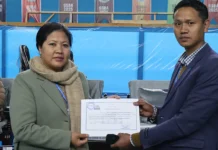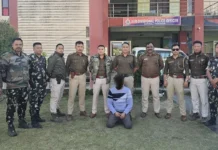[ Dr Hage Tabyo ]
Having grown up through beyond good five decades of winters, one of my insatiable desires is to share and tell about the tale of an indelible experience of the Chinese invasion in 1962 on the territories of India’s North East Frontier Agency (NEFA).
For not, that I was a practical witness of the battle scene during the agonizing one-month long horrified days of conflict, nor had I been able to attain an age mature enough to comprehend the magnitude of the infamous 1962 War, but for the reason that a critical imprint, the events of the Chinese aggression had planted into the nascent psyche of an eight year old, school going young man which still etches during winters and reverberates, far removed from my memory till this date.
The legendry Ziro hillock (Ziro Putu – in local term), situated at Old Ziro town was once occupied by a garrison brigade of the Indian Army since mid fifties, and was more popularly called as “Army Putu” by the locals. The entire army cantonment of that unique hillock was adorned with strange looking strips, aesthetically coloured and diagonally set uniform houses with green CGI sheets; walls and roofs bordered white, and a tinge of pink at edges and bottoms. With the outbreak of the Indo-China war in the Kameng Frontier Division, the constantly visible sight of the uniform clad army people suddenly vanished from Ziro town as the troop was moved to the forward front.
Mass exodus of people – both self and arranged -from Ziro Township started taking place. Porters were summoned by the administration from nearby states of Assam and Nagaland to help in the evacuation process.
Consequent upon the departure of all non-local people, the whole Ziro town was horribly desolate and the small but beautiful Ziro market place was not only empty and abandoned, but also most of the domestic goods which were not easily carryable back to the plains by their owners were found left scattered inside dwelling houses as well as outside and even in the middle of the market. Most houses were seen unlocked and left uncared for.
Ration goods, store items of town shop owners were similarly left abandoned at the shop sites. Few shrewd and far-sighted youths from nearby Apatani villages were smart enough to collect those unattended goods from the market premises, and eventually ended up as rich businessmen later by setting up shops with those collected stores and materials. Since our school teachers left for the plains, we the students enjoyed an abrupt and untimely school vacation during that period.
It was also found that few Apatanis made bunkers to hide themselves under ground during enemy bombing in bamboo grooves (bije) and dry agriculture lands (yorlu & lyapyo).
Rumors were doing rounds in plenty during the height of the war. The Ziro airfield was the epicenter of attention and mystery. It was rumored that some villagers saw a Chinese aeroplane landing at the Ziro airfield under darkness one night. People thought it to be a rehearsal by the Chinese enemy for a larger plan of their next move. People were just about panicky at all times.
At that time, the Kimin – Ziro link road construction by GREF was on in full swing and was reaching near Joram- Mai area.
Blasting on the road side was a common phenomenon, but each loud sound from the blasting was heard at Ziro town distinctly and contemplated as sounds coming from anticipated enemy bombing that was gradually nearing. Hence, some of the rich Apatanis started to slaughter their cattle and fowl, including mithuns, to fulfill a premortem/antemortem feast (Diibing diiniing) – a tradition usually observed by the Apatanis before the demise of their mortal frame from this earth.
Mr Shambu Boro, a friend of mine from Tezpur (Assam), shares his side of story relating to the infamous Chinese Aggression in which it was known that the PLA almost reached Tezpur by mid-November 1962. Mr Boro, at the time of war was a first year student of Darang College at Tezpur, who tells the sordid saga of those jittery days of his experience. He says – “panic gripped the entire town in those days. People of Tezpur were evacuated and shifted to the southern bank of River Brahmaputra so that they could either flee freely of their own or help moved further southward subsequently”.
He further adds – “A rumor had suddenly spread at one point that the Chinese Army had already captured the whole of NEFA. Even the DC of Tezpur town had fled leaving his office peon with a letter of order of instruction for the town inhabitants to leave the place within 24 hours. Thousands of people queued up at the church field ground ready for their turn to be evacuated. Boats and buses were lined up ready near Jahaighat. But nobody was available to drive the vehicle or the boat out of panic. Hence, people started to flee the town on foot to board the next rail trip down south towards Rongia and then Guwahati henceforth.
Around 10:30 am on the 20thNovember, 1962, one Pranab Sinha, who is now 75 years of age, was standing on a road between the central jail and mental hospital of Tezpur. He saw the awful sight of the prisoners from the jail and inmates of mental hospital suddenly coming out of their cells and roaming freely on the streets of Tezpur, raising slogans in praise of China, possibly pondering that they were freed because of China, for, before his leaving, the DC of Tezpur had ordered to free the jail prisoners and patients of the mental hospital.
There were many more stories – myths and maxims – emerging out of the 1962 Chinese Aggression from different people and places of Arunachal Pradesh and nearby Assam, which are equally intriguing. But all these have mingled in the history of a disastrously fought and hors-de combat war of Indian Republic. Most Indians even the contemporaries might well have forgotten the events of 1962 where thousands of patriotic soldiers were mercilessly butchered and much bloodshed ensued, but the scar has remained un-erased from the memory of each Arunachalee of times since the very war took place at the heart of our own home ground.
To sum up, the episode simply reminds me of Dr Bhupen Hazarika’s immortal master piece of that song about the event.
//Koto juwanor mrityu hol/kar jiwan jauban gol/hei mrityu aparajay/tene mritok noholu moi kiyo/aji kameng himanto dekhilu/dekhi hotrur pohutrok shinilu/ aru mrotok mauna koto juwanore
/mur ashru anjali jasilu/proti juwan roktore bindu/hal sahohar rononito hindu/kotojuwanor mrityu hol//
Translation: //So many valiant soldiers,/Their lives laid down!/How many severed heads-/Counted in savior of thy motherland ?/Why was me being not taken along,/To the party of that supreme sojourn ?/With awe, in Kameng frontier,/I have witnessed that wretched scene;/And saw the ruthless & animalistic notoriety of foes and sin;/Seeing the martyres’ noble sacrifice/I shed my endless tears and much saddened!/So many valiant soldiers,/Their lives – laid down.
(The contributor is a Former Director of Family Welfare, Arunachal Pradesh)



